| Are hostas just for the shade? |
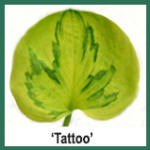 Traditionally, hostas
have been considered a "shade loving" plant but this
is at the least a great over statement. Hostas are
actually a shade tolerant plant which, like all
plants needs a certain amount of light to complete
photosynthesis. Some hostas may be grown in full sun
if given moisture and a moisture retentive soil. Also, certain hostas are more "sun tolerant"
than others by nature. Many hostas grow amongst
grasses or in crevices on mountain sides in their
native environments. Traditionally, hostas
have been considered a "shade loving" plant but this
is at the least a great over statement. Hostas are
actually a shade tolerant plant which, like all
plants needs a certain amount of light to complete
photosynthesis. Some hostas may be grown in full sun
if given moisture and a moisture retentive soil. Also, certain hostas are more "sun tolerant"
than others by nature. Many hostas grow amongst
grasses or in crevices on mountain sides in their
native environments.
|
 |
| What conditions are best for growing hostas? |
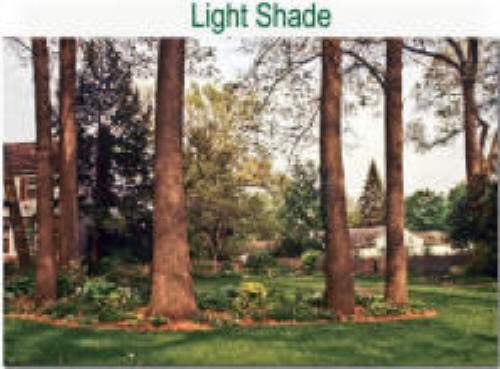 As shade tolerant
plants, most hostas will do best with some shade
especially in the afternoon when the sun is most
intense. They will survive and grow in very heavy
shade situations but will be slow to grow and form
mature clumps. Of course, hostas do well under most
trees, however, those with shallow roots such as
most maples may compete with the hostas for water
and nutrients causing them to struggle. As shade tolerant
plants, most hostas will do best with some shade
especially in the afternoon when the sun is most
intense. They will survive and grow in very heavy
shade situations but will be slow to grow and form
mature clumps. Of course, hostas do well under most
trees, however, those with shallow roots such as
most maples may compete with the hostas for water
and nutrients causing them to struggle.
|
 |
| What are the major problems of hostas? |
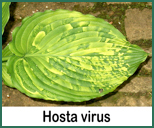 Again, traditionally,
hostas were known as a "caste iron" plant with no
problems. As the numbers of hostas being grown in
more and more gardens has expanded greatly, a few
common problems have started to show up. Tops on the list
are deer. They seem to love to chew off the leaves
of hostas leaving a celery looking stalk.
Slugs will chew on the leaves if the environment is
moist. Foliar nematodes may infest certain types of hostas and turn the tissue between the leaf veins
brown by late summer. Finally, the most serious
problem is infection by
viral disease. Fortunately,
none of these problems are super serious and none of
them should prevent you from growing hostas with
great results! Again, traditionally,
hostas were known as a "caste iron" plant with no
problems. As the numbers of hostas being grown in
more and more gardens has expanded greatly, a few
common problems have started to show up. Tops on the list
are deer. They seem to love to chew off the leaves
of hostas leaving a celery looking stalk.
Slugs will chew on the leaves if the environment is
moist. Foliar nematodes may infest certain types of hostas and turn the tissue between the leaf veins
brown by late summer. Finally, the most serious
problem is infection by
viral disease. Fortunately,
none of these problems are super serious and none of
them should prevent you from growing hostas with
great results!
|
 |
| Where are hostas found in the wild? |
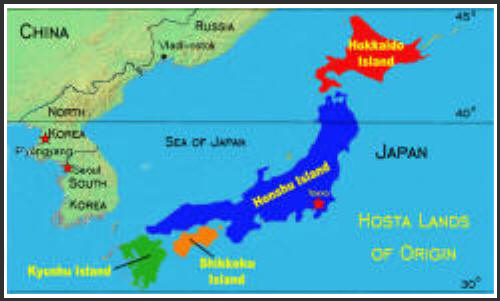 Most hosta species
are from the islands of
Japan, with a few
originating in Korea and a smaller number from
China. There are currently 42 species recognized
"officially". The most recent discoveries were
H.
yingeri and
H. jonesii which were
identified in the 1980s in Korea. Most hosta species
are from the islands of
Japan, with a few
originating in Korea and a smaller number from
China. There are currently 42 species recognized
"officially". The most recent discoveries were
H.
yingeri and
H. jonesii which were
identified in the 1980s in Korea.
|
 |
| How are hostas reproduced? |
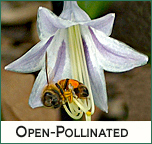 Like all plants,
hostas are reproduced
sexually (by seed) and asexually
(sports). Seeds are produced by pollen coming into
contact with the ovaries of the plant. In hostas,
this is most commonly done by bees but a group of
people called hybridizers actively move the pollen
from the stamen and onto the pistil of the same or a
different hosta of their choice. They keep
records of the parents and plant the seeds after
harvest in the fall. Out of hundreds or even thousands of seedlings
and after careful evaluation, they may choose one or two
(or none) to name as a new cultivar. Like all plants,
hostas are reproduced
sexually (by seed) and asexually
(sports). Seeds are produced by pollen coming into
contact with the ovaries of the plant. In hostas,
this is most commonly done by bees but a group of
people called hybridizers actively move the pollen
from the stamen and onto the pistil of the same or a
different hosta of their choice. They keep
records of the parents and plant the seeds after
harvest in the fall. Out of hundreds or even thousands of seedlings
and after careful evaluation, they may choose one or two
(or none) to name as a new cultivar.
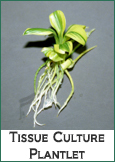 Sports occur when a
part of the mother plant spontaneously changes. So,
that green hosta suddenly emerges in the spring with
one division that has yellow leaf margins. Separate
that division and, if it is unique enough, you have
a new cultivar. In recent decades, a commercial
micro-propagation technique called
tissue culture (TC)
is capable of creating hundreds or even thousands of
clones of a single mother plant very quickly. These
large numbers plus the use of certain chemicals in
the process result in many sports in a batch of
otherwise uniform clones. A high percentage of the
variegated hostas introduced now come from TC. Sports occur when a
part of the mother plant spontaneously changes. So,
that green hosta suddenly emerges in the spring with
one division that has yellow leaf margins. Separate
that division and, if it is unique enough, you have
a new cultivar. In recent decades, a commercial
micro-propagation technique called
tissue culture (TC)
is capable of creating hundreds or even thousands of
clones of a single mother plant very quickly. These
large numbers plus the use of certain chemicals in
the process result in many sports in a batch of
otherwise uniform clones. A high percentage of the
variegated hostas introduced now come from TC.
|
 |
| Why are there so many different named hostas? |
 As far as we can
tell, there are around 10,000 named hostas. This
sounds like a lot but consider that there are over
70,000 named daylilies. Anyway, anyone can pick a hosta
seedling or sport from their garden and give it a name. Some of
these plants never leave the originator's property
but there names show up on a website or in a book.
There are probably no more than 1,000 or 2,000 hosta cultivars or
species available in nurseries scattered across the U.S.,
Canada, Europe and Japan or on the Web. As far as we can
tell, there are around 10,000 named hostas. This
sounds like a lot but consider that there are over
70,000 named daylilies. Anyway, anyone can pick a hosta
seedling or sport from their garden and give it a name. Some of
these plants never leave the originator's property
but there names show up on a website or in a book.
There are probably no more than 1,000 or 2,000 hosta cultivars or
species available in nurseries scattered across the U.S.,
Canada, Europe and Japan or on the Web.

|
 |
| What are some good resources for learning about hostas? |
  In addition to
The Hosta Helper Site Map (had to get a plug in), there are
several books and websites where you can start to
make some sense of the hosta world. A few of these
would include the annual
Hosta Popularity Poll by
The American Hosta Society. The
Hosta of the Year
award by the American Hosta Grower's Association. In addition to
The Hosta Helper Site Map (had to get a plug in), there are
several books and websites where you can start to
make some sense of the hosta world. A few of these
would include the annual
Hosta Popularity Poll by
The American Hosta Society. The
Hosta of the Year
award by the American Hosta Grower's Association.
Among the many fine books on hostas,
The Hostapedia
(2009)
by renowned hosta expert,
Mark Zilis is a great
resource for both beginners and veterans. To go
deeper into the historical aspects of hostas,
The
Genus Hosta by
W. George Schmid (1991) is a great
reference. Click on
the books link above for a more inclusive list.
|
 |
| Which hostas are in the genetic background of many
of the named cultivars? |
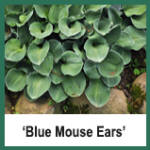 There are many thousands of hostas which have
been used as parent plants for hybrids or sports.
However, there are handful of species and cultivars
which appear in the pedigree of large numbers of new
cultivars. Tops on this list is H. 'Sieboldiana'
and its most famous offspring H. 'Elegans' which are in the
background of well over 3,000 hosta cultivars. If
you see a large, blue-green hosta, odds are that one
or both of these plants are in its genetic makeup. There are many thousands of hostas which have
been used as parent plants for hybrids or sports.
However, there are handful of species and cultivars
which appear in the pedigree of large numbers of new
cultivars. Tops on this list is H. 'Sieboldiana'
and its most famous offspring H. 'Elegans' which are in the
background of well over 3,000 hosta cultivars. If
you see a large, blue-green hosta, odds are that one
or both of these plants are in its genetic makeup.
Other cultivars you will frequently see in the
genetic background of many hostas would include H. 'Beatrice', H. 'Dorothy
Benedict', H. 'Flamboyant', H. 'Frances
Williams', H. 'Tokudama'
and
H. 'Tardiflora'. Species in the background of many hostas
would include
H. longipes,
H. montana,
H. nakaiana,
H. nigrescens,
H. plantaginea,
H. sieboldii
and
H. venusta. Each of these
plants is in the genetic heritage of at least 250
named cultivars.
|
 |
| What is The American Hosta Society? |
 It
is always helpful to have a group of people who
share a common interest. They can share information,
experiences and provide fellowship.
The American Hosta Society (the
"The" is capitalized and part of the official name) is the
premiere organization for this plant species in the
U.S. It holds a national convention each year
featuring some of the top private and public hosta
gardens along with educational programs. Even if you
don't attend the conventions, it is worth joining in
order to receive
The Hosta Journal
(again, the "The" is capitalized and part of the
official name) It
is always helpful to have a group of people who
share a common interest. They can share information,
experiences and provide fellowship.
The American Hosta Society (the
"The" is capitalized and part of the official name) is the
premiere organization for this plant species in the
U.S. It holds a national convention each year
featuring some of the top private and public hosta
gardens along with educational programs. Even if you
don't attend the conventions, it is worth joining in
order to receive
The Hosta Journal
(again, the "The" is capitalized and part of the
official name)
|
 |
|
More questions? |
The Hosta Helper
has nearly 60,000 pages of information on all
aspects of the genus, Hosta. Useful links may
be found on our large Site Map page. Information is
organized in the following units: Have other
questions you think should be included?
Click Here
|



